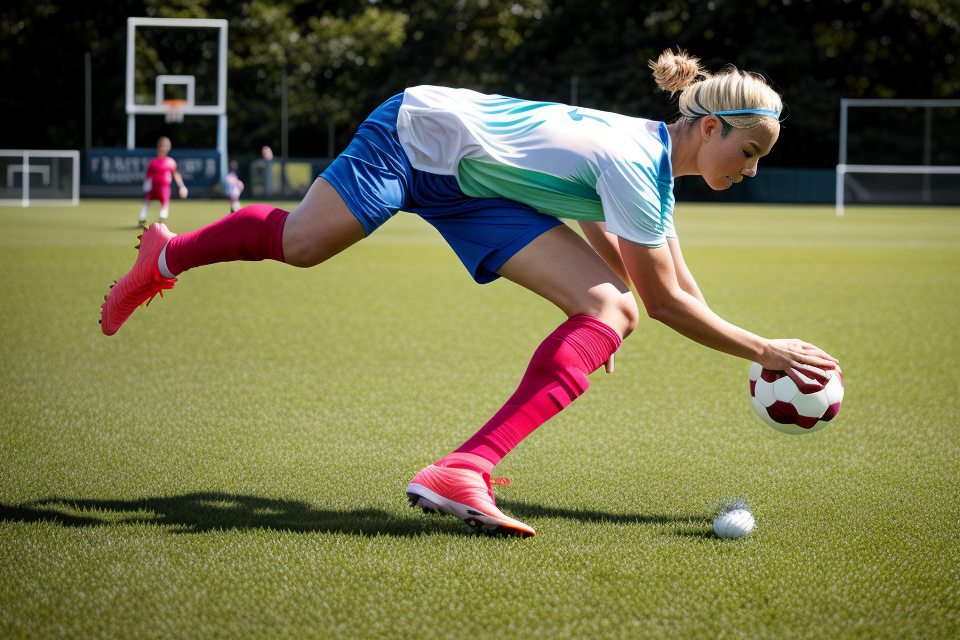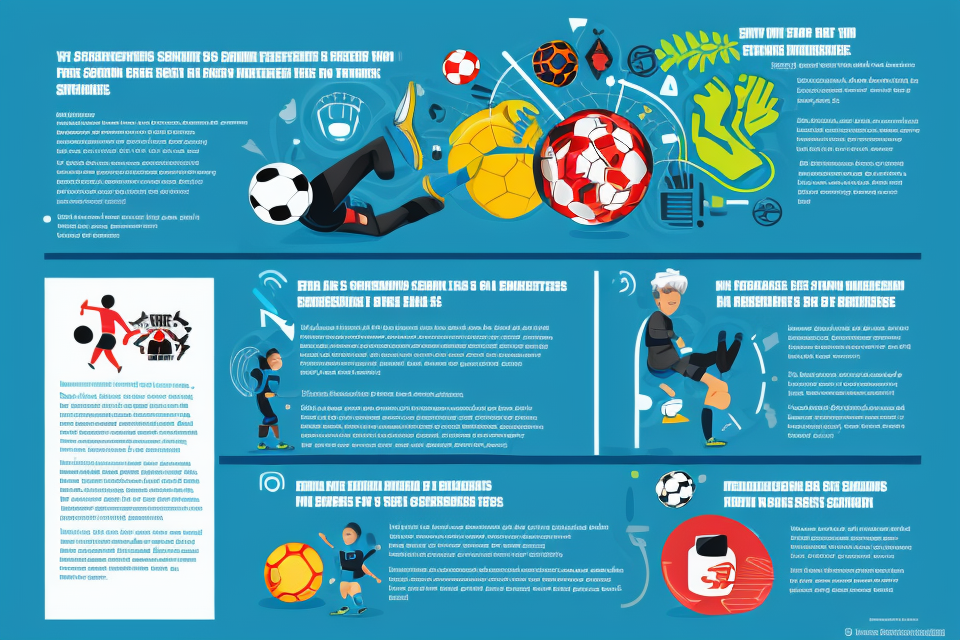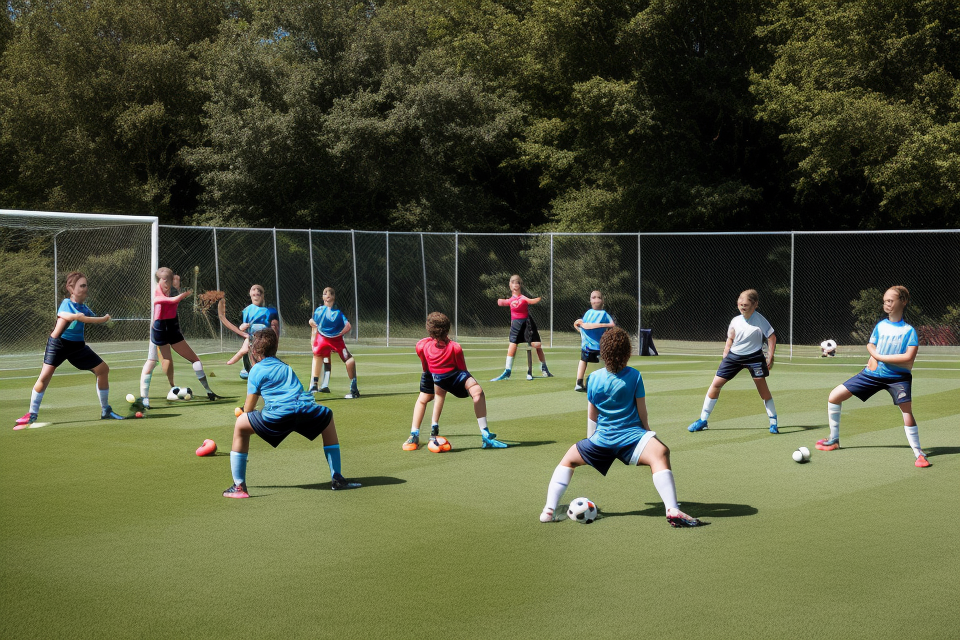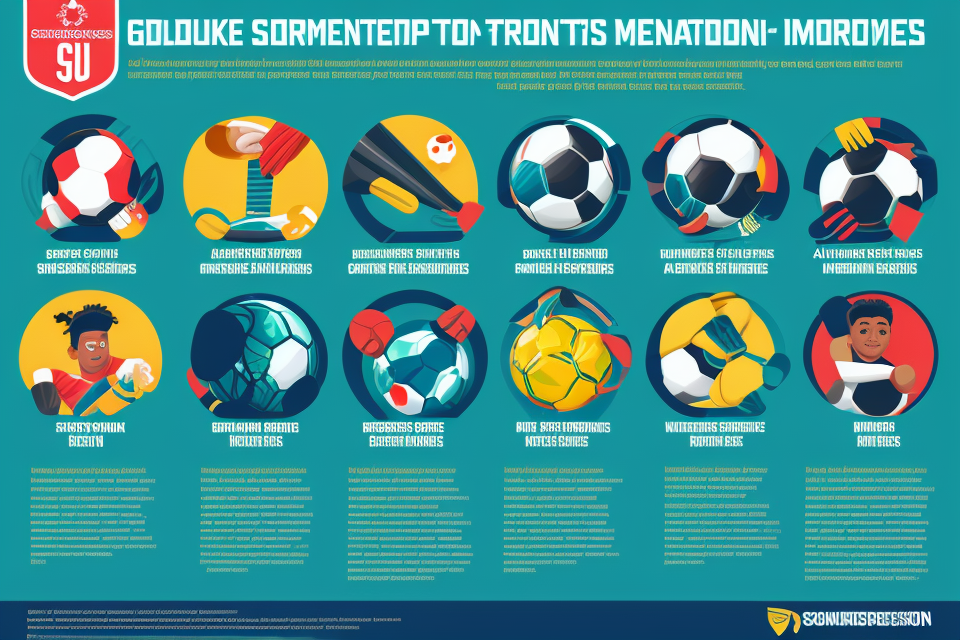Soccer is a beloved sport around the world, enjoyed by millions of players of all ages and skill levels. However, one of the most common injuries sustained by soccer players is a knee injury. Knee injuries can be debilitating and can keep players out of the game for an extended period. Therefore, it is essential to take preventative measures to protect your knees while playing soccer. In this article, we will explore some tips and techniques to help you prevent knee injuries while playing soccer. So, let’s get started!
Understanding the Risks of Knee Injuries in Soccer
Common Types of Knee Injuries in Soccer
- Anterior cruciate ligament (ACL) tears: ACL tears are one of the most common knee injuries in soccer. This injury occurs when the ACL, which is a ligament that runs from the thigh bone to the shin bone, is stretched or torn. This can happen when a player changes direction quickly, stops suddenly, or lands incorrectly after a jump.
- Medial collateral ligament (MCL) sprains: MCL sprains are another common knee injury in soccer. The MCL is a ligament that runs along the inner knee and helps stabilize the knee joint. MCL sprains can occur when a player’s knee is hit from the side, causing the ligament to stretch or tear.
- Meniscus tears: The meniscus is a cartilage that cushions the knee joint. Meniscus tears can occur in soccer when a player twists or turns suddenly, causing the cartilage to tear. This can happen during a tackle or when a player is changing direction quickly.
Factors Contributing to Knee Injuries in Soccer
Soccer is a physically demanding sport that requires players to perform various movements, including running, jumping, and changing direction rapidly. These movements can put a significant amount of stress on the knee joint, making it susceptible to injuries. Several factors contribute to knee injuries in soccer, including:
- Poor footwork and technique: Poor footwork and technique can lead to improper landing and movement patterns, which can cause excessive stress on the knee joint and increase the risk of injury.
- Insufficient warm-up and stretching: Failing to properly warm up and stretch before playing soccer can put the knee joint at risk of injury. A proper warm-up and stretching routine should include dynamic stretches that focus on the legs and knee joint.
- Overuse and fatigue: Playing soccer regularly can lead to overuse and fatigue of the knee joint, increasing the risk of injury. It is essential to allow adequate recovery time between games and training sessions.
- Inadequate equipment and footwear: Wearing improper footwear or using inadequate equipment can increase the risk of knee injuries in soccer. It is important to choose appropriate footwear that provides adequate support and protection for the knee joint.
Preparing Your Body for Soccer: Pre-season and In-season Training
Developing Strength and Flexibility
As a soccer player, it is essential to develop both strength and flexibility to prevent knee injuries. Strengthening the muscles around the knee joint, as well as improving overall body control, can help reduce the risk of injury. Here are some specific exercises and techniques to help you develop strength and flexibility:
- Focusing on lower body strength training: Incorporating exercises that target the muscles in your lower body can help improve your overall stability and reduce the risk of knee injuries. Some examples of lower body strength training exercises include squats, lunges, and deadlifts. It is important to perform these exercises with proper form to avoid injury and maximize their effectiveness.
- Incorporating plyometrics and balance exercises: Plyometrics are explosive movements that can help improve your power and speed on the soccer field. Examples of plyometric exercises include box jumps and bounding. Balance exercises, such as single-leg squats and single-leg deadlifts, can also help improve your stability and reduce the risk of injury.
- Improving core stability and hip mobility: Strong core muscles and flexible hips can help improve your overall body control and reduce the risk of knee injuries. Exercises such as planks, Russian twists, and hip openers can help improve core stability and hip mobility.
Overall, incorporating a combination of lower body strength training, plyometrics, balance exercises, and core stability and hip mobility exercises can help improve your overall strength and flexibility, and reduce the risk of knee injuries while playing soccer.
Building Endurance and Conditioning
As a soccer player, building endurance and conditioning is crucial to preventing knee injuries. Endurance training helps to increase the heart rate and improve the cardiovascular system, while conditioning helps to build strength and muscle tone. There are several methods of building endurance and conditioning, including progressive endurance training, interval training, and match simulation drills.
- Progressive Endurance Training:
This type of training involves gradually increasing the intensity and duration of workouts over time. It can be done through running or cycling, and the goal is to build up to a specific distance or time goal. For example, a player might start with a 5-mile run and gradually increase the distance each week until they can run 10 miles without stopping. This type of training helps to build endurance and stamina, which can help prevent injuries. - Interval Training:
Interval training involves alternating periods of high-intensity exercise with periods of rest or low-intensity exercise. This type of training can be done through running, cycling, or swimming, and it is effective in building endurance and improving cardiovascular health. For example, a player might alternate between sprinting and jogging for a set period of time, such as 30 seconds of sprinting followed by 30 seconds of jogging. This type of training can help to build strength and endurance, which can help prevent injuries. - Match Simulation Drills:
Match simulation drills involve performing exercises that simulate the physical demands of a soccer match. These drills can help to build endurance and conditioning while also improving technical skills and game awareness. For example, a player might perform drills that simulate running with the ball, passing, and shooting, all while performing exercises that build strength and endurance. This type of training can help to prepare the body for the physical demands of a soccer match, which can help prevent injuries.
In summary, building endurance and conditioning is an essential part of preventing knee injuries while playing soccer. Progressive endurance training, interval training, and match simulation drills are all effective methods of building endurance and conditioning, and they can help to improve cardiovascular health, build strength and muscle tone, and prepare the body for the physical demands of a soccer match.
Proper Warm-up and Cool-down Techniques
- Dynamic stretching: Before beginning any physical activity, it is essential to perform dynamic stretching. This type of stretching involves active movements that prepare the muscles and joints for activity. Examples of dynamic stretches include leg swings, arm circles, and hip openers.
- Joint mobility exercises: Joint mobility exercises are designed to improve the range of motion in the joints. These exercises can help prevent knee injuries by increasing the flexibility and strength of the surrounding muscles and ligaments. Examples of joint mobility exercises include leg squats, lunges, and leg extensions.
- Foam rolling and self-massage: Foam rolling is a technique that involves using a foam roller to apply pressure to tight or sore muscles. This technique can help release tension in the muscles and improve circulation. Self-massage involves using your hands to massage the muscles and increase blood flow. Both techniques can help prevent knee injuries by reducing muscle tension and improving circulation.
Improving Your Soccer Technique to Reduce Knee Injury Risk
Proper Kicking Technique
- Using proper kicking form: The first step in preventing knee injuries while playing soccer is to use proper kicking form. This means ensuring that your legs, hips, and torso are aligned correctly during the kicking motion. Keep your knees bent and your foot flexed to avoid putting too much stress on your joints.
- Gradually increasing intensity and power: As you improve your kicking technique, gradually increase the intensity and power of your kicks. This will help you build muscle strength and avoid overexertion, which can lead to knee injuries.
- Warming up before attempting high-impact kicks: Finally, it’s important to warm up before attempting high-impact kicks. This can include light jogging, stretching, and dynamic exercises to prepare your muscles for the demands of the game.
Cutting and Change of Direction
Cutting and change of direction are essential skills in soccer that require quick and precise movements. However, these movements can also put a significant amount of stress on the knee, increasing the risk of injury. To reduce the risk of knee injuries while cutting and changing direction, follow these essential tips and techniques:
- Reducing the impact of quick stops and turns: When making quick stops or turns, it’s important to reduce the impact on the knee by using proper technique. This can be achieved by using a slight bend in the knees and hips, which can help absorb the shock and prevent the knee from twisting or hyperextending.
- Developing proper body alignment and balance: Proper body alignment and balance are crucial when making quick cuts and changes of direction. Players should maintain a neutral spine and keep their weight centered over their feet, which can help prevent the knee from being put in awkward positions.
- Practicing explosive movements with control: Explosive movements, such as sudden changes of direction or quick starts and stops, can put a significant amount of stress on the knee. To reduce the risk of injury, it’s important to practice these movements with control, using proper technique and gradually increasing intensity over time.
By following these essential tips and techniques, players can improve their soccer technique and reduce the risk of knee injuries while cutting and changing direction.
Jumping and Landing Techniques
Proper takeoff and landing mechanics are crucial in preventing knee injuries while playing soccer. When taking off for a jump, it is important to bend your knees and keep your feet hip-width apart. This positioning allows for a more controlled takeoff and reduces the risk of landing awkwardly. When landing, it is important to use the same mechanics by bending your knees and slowly returning to a standing position. Gradual progression of jump height and distance should also be considered to prevent overexertion and injury. Strengthening the lower extremities, specifically the quadriceps and hamstrings, can also help reduce the risk of knee injuries while playing soccer. Incorporating exercises such as squats and lunges into your training regimen can help build strength and stability in the knee joint.
Injury Prevention Strategies During Soccer Matches and Practices
Hydration and Nutrition
Maintaining proper hydration and a balanced diet is crucial for soccer players to prevent knee injuries. Here are some essential tips to ensure adequate hydration and nutrition:
- Proper Hydration: Dehydration can significantly increase the risk of knee injuries in soccer players. It is important to drink water or sports drinks containing electrolytes before, during, and after matches to maintain hydration levels. Adequate hydration helps in maintaining joint lubrication, which reduces the risk of injury.
- Consuming a Balanced Diet: A balanced diet rich in nutrients is essential for overall health and injury prevention. Soccer players should focus on consuming a diet that includes a mix of fruits, vegetables, whole grains, lean proteins, and healthy fats. This ensures that the body receives all the necessary nutrients for optimal performance and injury prevention.
- Limiting Sugar and Caffeine Intake: Consuming excessive sugar and caffeine can lead to dehydration and negatively impact overall health. It is essential to limit sugar intake by consuming whole foods and avoiding sugary drinks. Caffeine should also be consumed in moderation, as it can lead to dehydration and affect performance.
By following these hydration and nutrition tips, soccer players can significantly reduce their risk of knee injuries and improve their overall performance on the field.
Proper Equipment and Footwear
When it comes to preventing knee injuries while playing soccer, one of the most effective strategies is to ensure that you have the proper equipment and footwear. This can make a significant difference in your ability to perform at your best and reduce your risk of injury. Here are some essential tips to keep in mind:
Choosing appropriate shoes for field conditions
One of the most important factors in preventing knee injuries while playing soccer is choosing the right shoes for the field conditions. For example, if you’re playing on a wet or muddy field, you’ll want to choose shoes with a good grip on the bottom to prevent slips and falls. On the other hand, if you’re playing on a dry, hard field, you’ll want shoes that provide good support and cushioning to protect your knees from impact.
Regularly replacing worn-out cleats
Another important factor in preventing knee injuries while playing soccer is regularly replacing worn-out cleats. Cleats are designed to provide support and stability to your feet and ankles, which can help prevent knee injuries. However, when your cleats become worn out, they may not provide the support you need, which can increase your risk of injury. It’s essential to replace your cleats every few months to ensure that they’re still providing the support you need.
Wearing proper protective gear, such as shin guards
Wearing proper protective gear, such as shin guards, is another essential strategy for preventing knee injuries while playing soccer. Shin guards are designed to protect your shins and knees from impact and can help prevent injuries such as shin splints and patellar tendinitis. When choosing shin guards, it’s important to select ones that fit well and provide adequate protection. It’s also essential to wear them properly, ensuring that they’re secured tightly to your legs to provide maximum protection.
Communication and Teamwork
Effective communication and teamwork are essential components of injury prevention in soccer. By working together and being aware of potential hazards on the field, players can minimize the risk of knee injuries. Here are some specific strategies for promoting communication and teamwork during soccer matches and practices:
- Communicating with teammates about injuries and concerns: If a player experiences a knee injury or has concerns about their knee health, it is important to communicate with their teammates. By sharing information and working together, players can develop strategies for preventing injuries and supporting each other during matches and practices.
- Encouraging open communication and support among teammates: Building a supportive team environment is key to preventing knee injuries in soccer. Players should be encouraged to communicate openly and honestly with each other about their injuries and concerns, and to offer support and encouragement to teammates who are recovering from injuries.
- Being aware of potential hazards on the field: Finally, players should be aware of potential hazards on the field that could lead to knee injuries. This includes uneven surfaces, slippery conditions, and other environmental factors that could increase the risk of injury. By being aware of these hazards and working together to avoid them, players can reduce the risk of knee injuries and stay healthy throughout the season.
Addressing Pain and Seeking Professional Help
Recognizing Signs of Knee Injuries
When it comes to recognizing signs of knee injuries while playing soccer, it is important to pay attention to the following:
- Swelling, pain, or stiffness: If you experience any of these symptoms in your knee, it could be a sign of an injury. Swelling and pain are particularly indicative of a potential injury, as they are typically accompanied by discomfort or difficulty with movement.
- Difficulty bearing weight on the affected knee: If you find that you are unable to put weight on your knee without experiencing pain or discomfort, this could be a sign of an injury. This is particularly true if the pain is concentrated in a specific area of the knee or if you feel a sharp pain when you attempt to bear weight on the affected leg.
- Instability or locking of the knee joint: If you experience instability or locking of the knee joint, it could be a sign of an injury. This is particularly true if you feel as though your knee is giving out or if you are unable to fully extend or flex your knee without experiencing pain or discomfort.
It is important to note that these symptoms can vary in severity and may not always be present in every knee injury. However, if you experience any of these symptoms while playing soccer, it is important to seek professional help as soon as possible to prevent further injury and ensure a speedy recovery.
Seeking Medical Advice
When experiencing knee pain or discomfort while playing soccer, it is crucial to seek medical advice from a sports medicine professional or orthopedic specialist. These healthcare experts are well-versed in diagnosing and treating knee injuries, as well as providing guidance on proper rehabilitation and recovery.
Consulting a sports medicine professional or orthopedic specialist
To begin, it is essential to schedule an appointment with a sports medicine professional or orthopedic specialist. These healthcare providers are equipped to evaluate the severity of the knee injury and recommend the most appropriate course of treatment.
During the consultation, the specialist will likely conduct a thorough physical examination, including a review of the patient’s medical history and a detailed assessment of the knee’s range of motion, stability, and strength.
Following recommended treatment and rehabilitation plans
Once a diagnosis has been made, the specialist will provide a comprehensive treatment plan tailored to the individual’s specific needs. This may include various therapeutic interventions, such as pain management, physical therapy, or surgical intervention, depending on the severity of the injury.
It is crucial to follow the recommended treatment and rehabilitation plans precisely, as adhering to these guidelines will help ensure a successful recovery and minimize the risk of future knee injuries.
Gradually returning to play after a knee injury
After completing the rehabilitation process, it is important to gradually return to soccer-related activities. This gradual progression will help prevent reinjury and ensure that the knee is adequately prepared for the physical demands of the sport.
In conclusion, seeking medical advice from a sports medicine professional or orthopedic specialist is an essential step in addressing knee pain or discomfort while playing soccer. By following their recommended treatment and rehabilitation plans, and gradually returning to play, individuals can significantly reduce the risk of future knee injuries and promote a safe and successful soccer career.
FAQs
1. What are the most common knee injuries in soccer players?
Answer:
The most common knee injuries in soccer players are anterior cruciate ligament (ACL) tears and medial collateral ligament (MCL) sprains. ACL tears are often caused by sudden changes in direction or landing awkwardly, while MCL sprains are usually the result of a direct blow to the knee. Other common knee injuries include meniscal tears and patellar tendonitis.
2. How can I prevent knee injuries while playing soccer?
There are several steps you can take to prevent knee injuries while playing soccer. First, make sure to properly warm up before each game or practice. This can help to increase blood flow to the muscles and reduce the risk of injury. Additionally, it’s important to stay hydrated during the game, as dehydration can increase the risk of injury. Another key step is to maintain good technique when making turns and changing direction, as this can help to reduce the stress on your knees. Finally, make sure to properly cool down and stretch after each game or practice to help prevent soreness and injury.
3. What type of shoes should I wear to protect my knees while playing soccer?
When it comes to choosing shoes for soccer, it’s important to look for a pair that provides good support and cushioning. This can help to reduce the impact on your knees and lower back. Look for shoes with a sturdy sole that provides good traction on the field, as well as a good fit around the ankle to help prevent sprains. It’s also a good idea to choose shoes with a good arch support, as this can help to reduce the strain on your knees.
4. Should I wear a brace or other protective gear to prevent knee injuries in soccer?
Wearing a brace or other protective gear can be a good idea to help prevent knee injuries in soccer. A brace can help to provide extra support and stability to the knee, particularly if you have a history of knee injuries or instability. There are several different types of knee braces available, including neoprene sleeves, hinged braces, and unloading braces. It’s a good idea to consult with a sports medicine professional to determine which type of brace is best for your needs.
5. How can I strengthen my knees to prevent injuries in soccer?
Strengthening the muscles around the knee can be a good way to prevent injuries in soccer. The quadriceps, hamstrings, and calf muscles all play an important role in supporting the knee and reducing the risk of injury. You can work on strengthening these muscles through a combination of strength training exercises and plyometrics. It’s important to consult with a sports medicine professional or certified trainer to ensure that you are performing the exercises correctly and safely.



